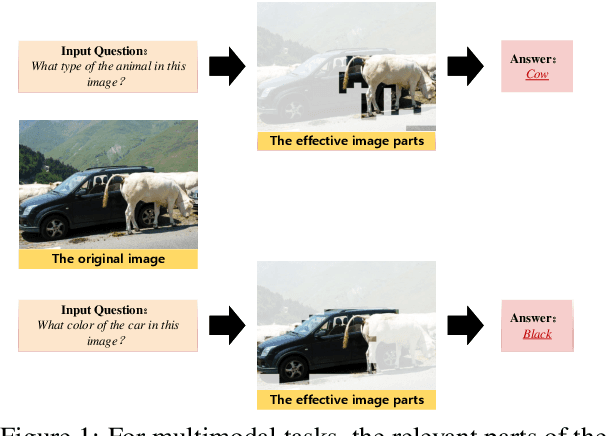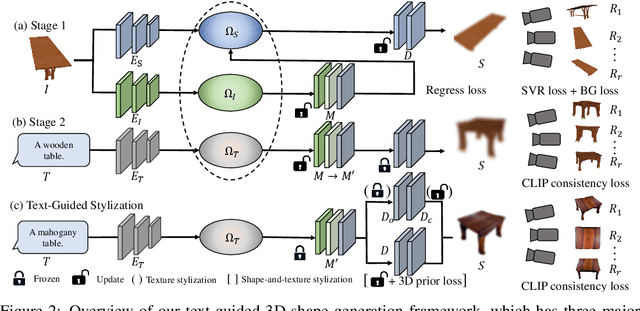Ruihui Li
Self-Supervised Point Cloud Completion based on Multi-View Augmentations of Single Partial Point Cloud
Sep 26, 2025Abstract:Point cloud completion aims to reconstruct complete shapes from partial observations. Although current methods have achieved remarkable performance, they still have some limitations: Supervised methods heavily rely on ground truth, which limits their generalization to real-world datasets due to the synthetic-to-real domain gap. Unsupervised methods require complete point clouds to compose unpaired training data, and weakly-supervised methods need multi-view observations of the object. Existing self-supervised methods frequently produce unsatisfactory predictions due to the limited capabilities of their self-supervised signals. To overcome these challenges, we propose a novel self-supervised point cloud completion method. We design a set of novel self-supervised signals based on multi-view augmentations of the single partial point cloud. Additionally, to enhance the model's learning ability, we first incorporate Mamba into self-supervised point cloud completion task, encouraging the model to generate point clouds with better quality. Experiments on synthetic and real-world datasets demonstrate that our method achieves state-of-the-art results.
VLScene: Vision-Language Guidance Distillation for Camera-Based 3D Semantic Scene Completion
Mar 08, 2025Abstract:Camera-based 3D semantic scene completion (SSC) provides dense geometric and semantic perception for autonomous driving. However, images provide limited information making the model susceptible to geometric ambiguity caused by occlusion and perspective distortion. Existing methods often lack explicit semantic modeling between objects, limiting their perception of 3D semantic context. To address these challenges, we propose a novel method VLScene: Vision-Language Guidance Distillation for Camera-based 3D Semantic Scene Completion. The key insight is to use the vision-language model to introduce high-level semantic priors to provide the object spatial context required for 3D scene understanding. Specifically, we design a vision-language guidance distillation process to enhance image features, which can effectively capture semantic knowledge from the surrounding environment and improve spatial context reasoning. In addition, we introduce a geometric-semantic sparse awareness mechanism to propagate geometric structures in the neighborhood and enhance semantic information through contextual sparse interactions. Experimental results demonstrate that VLScene achieves rank-1st performance on challenging benchmarks--SemanticKITTI and SSCBench-KITTI-360, yielding remarkably mIoU scores of 17.52 and 19.10, respectively.
Vision-based 3D Semantic Scene Completion via Capture Dynamic Representations
Mar 08, 2025Abstract:The vision-based semantic scene completion task aims to predict dense geometric and semantic 3D scene representations from 2D images. However, the presence of dynamic objects in the scene seriously affects the accuracy of the model inferring 3D structures from 2D images. Existing methods simply stack multiple frames of image input to increase dense scene semantic information, but ignore the fact that dynamic objects and non-texture areas violate multi-view consistency and matching reliability. To address these issues, we propose a novel method, CDScene: Vision-based Robust Semantic Scene Completion via Capturing Dynamic Representations. First, we leverage a multimodal large-scale model to extract 2D explicit semantics and align them into 3D space. Second, we exploit the characteristics of monocular and stereo depth to decouple scene information into dynamic and static features. The dynamic features contain structural relationships around dynamic objects, and the static features contain dense contextual spatial information. Finally, we design a dynamic-static adaptive fusion module to effectively extract and aggregate complementary features, achieving robust and accurate semantic scene completion in autonomous driving scenarios. Extensive experimental results on the SemanticKITTI, SSCBench-KITTI360, and SemanticKITTI-C datasets demonstrate the superiority and robustness of CDScene over existing state-of-the-art methods.
Learning Temporal 3D Semantic Scene Completion via Optical Flow Guidance
Feb 20, 2025Abstract:3D Semantic Scene Completion (SSC) provides comprehensive scene geometry and semantics for autonomous driving perception, which is crucial for enabling accurate and reliable decision-making. However, existing SSC methods are limited to capturing sparse information from the current frame or naively stacking multi-frame temporal features, thereby failing to acquire effective scene context. These approaches ignore critical motion dynamics and struggle to achieve temporal consistency. To address the above challenges, we propose a novel temporal SSC method FlowScene: Learning Temporal 3D Semantic Scene Completion via Optical Flow Guidance. By leveraging optical flow, FlowScene can integrate motion, different viewpoints, occlusions, and other contextual cues, thereby significantly improving the accuracy of 3D scene completion. Specifically, our framework introduces two key components: (1) a Flow-Guided Temporal Aggregation module that aligns and aggregates temporal features using optical flow, capturing motion-aware context and deformable structures; and (2) an Occlusion-Guided Voxel Refinement module that injects occlusion masks and temporally aggregated features into 3D voxel space, adaptively refining voxel representations for explicit geometric modeling. Experimental results demonstrate that FlowScene achieves state-of-the-art performance on the SemanticKITTI and SSCBench-KITTI-360 benchmarks.
Retrieval Replace Reduction: An effective visual token reduction method via semantic match
Oct 09, 2024



Abstract:Multimodal large language models (MLLMs) have demonstrated strong performance across various tasks without requiring training from scratch. However, they face significant computational and memory constraints, particularly when processing multimodal inputs that exceed context length, limiting their scalability. In this paper, we introduce a new approach, \textbf{TRSM} (\textbf{T}oken \textbf{R}eduction via \textbf{S}emantic \textbf{M}atch), which effectively reduces the number of visual tokens without compromising MLLM performance. Inspired by how humans process multimodal tasks, TRSM leverages semantic information from one modality to match relevant semantics in another, reducing the number of visual tokens.Specifically, to retain task relevant visual tokens, we use the text prompt as a query vector to retrieve the most similar vectors from the visual prompt and merge them with the text tokens. Based on experimental results, when applied to LLaVA-1.5\cite{liu2023}, our approach compresses the visual tokens by 20\%, achieving comparable performance across diverse visual question-answering and reasoning tasks.
Artistic Portrait Drawing with Vector Strokes
Oct 05, 2024



Abstract:In this paper, we present a method, VectorPD, for converting a given human face image into a vector portrait sketch. VectorPD supports different levels of abstraction by simply controlling the number of strokes. Since vector graphics are composed of different shape primitives, it is challenging for rendering complex faces to accurately express facial details and structure. To address this, VectorPD employs a novel two-round optimization mechanism. We first initialize the strokes with facial keypoints, and generate a basic portrait sketch by a CLIP-based Semantic Loss. Then we complete the face structure through VGG-based Structure Loss, and propose a novel Crop-based Shadow Loss to enrich the shadow details of the sketch, achieving a visually pleasing portrait sketch. Quantitative and qualitative evaluations both demonstrate that the portrait sketches generated by VectorPD can produce better visual effects than existing state-of-the-art methods, maintaining as much fidelity as possible at different levels of abstraction.
Multi-Round Region-Based Optimization for Scene Sketching
Oct 05, 2024Abstract:Scene sketching is to convert a scene into a simplified, abstract representation that captures the essential elements and composition of the original scene. It requires semantic understanding of the scene and consideration of different regions within the scene. Since scenes often contain diverse visual information across various regions, such as foreground objects, background elements, and spatial divisions, dealing with these different regions poses unique difficulties. In this paper, we define a sketch as some sets of Bezier curves. We optimize the different regions of input scene in multiple rounds. In each round of optimization, strokes sampled from the next region can seamlessly be integrated into the sketch generated in the previous round of optimization. We propose additional stroke initialization method to ensure the integrity of the scene and the convergence of optimization. A novel CLIP-Based Semantic loss and a VGG-Based Feature loss are utilized to guide our multi-round optimization. Extensive experimental results on the quality and quantity of the generated sketches confirm the effectiveness of our method.
ISS++: Image as Stepping Stone for Text-Guided 3D Shape Generation
Mar 24, 2023



Abstract:In this paper, we present a new text-guided 3D shape generation approach (ISS++) that uses images as a stepping stone to bridge the gap between text and shape modalities for generating 3D shapes without requiring paired text and 3D data. The core of our approach is a two-stage feature-space alignment strategy that leverages a pre-trained single-view reconstruction (SVR) model to map CLIP features to shapes: to begin with, map the CLIP image feature to the detail-rich 3D shape space of the SVR model, then map the CLIP text feature to the 3D shape space through encouraging the CLIP-consistency between rendered images and the input text. Besides, to extend beyond the generative capability of the SVR model, we design a text-guided 3D shape stylization module that can enhance the output shapes with novel structures and textures. Further, we exploit pre-trained text-to-image diffusion models to enhance the generative diversity, fidelity, and stylization capability. Our approach is generic, flexible, and scalable, and it can be easily integrated with various SVR models to expand the generative space and improve the generative fidelity. Extensive experimental results demonstrate that our approach outperforms the state-of-the-art methods in terms of generative quality and consistency with the input text. Codes and models are released at https://github.com/liuzhengzhe/ISS-Image-as-Stepping-Stone-for-Text-Guided-3D-Shape-Generation.
Neural Wavelet-domain Diffusion for 3D Shape Generation, Inversion, and Manipulation
Feb 01, 2023



Abstract:This paper presents a new approach for 3D shape generation, inversion, and manipulation, through a direct generative modeling on a continuous implicit representation in wavelet domain. Specifically, we propose a compact wavelet representation with a pair of coarse and detail coefficient volumes to implicitly represent 3D shapes via truncated signed distance functions and multi-scale biorthogonal wavelets. Then, we design a pair of neural networks: a diffusion-based generator to produce diverse shapes in the form of the coarse coefficient volumes and a detail predictor to produce compatible detail coefficient volumes for introducing fine structures and details. Further, we may jointly train an encoder network to learn a latent space for inverting shapes, allowing us to enable a rich variety of whole-shape and region-aware shape manipulations. Both quantitative and qualitative experimental results manifest the compelling shape generation, inversion, and manipulation capabilities of our approach over the state-of-the-art methods.
ISS: Image as Stepping Stone for Text-Guided 3D Shape Generation
Sep 22, 2022



Abstract:Text-guided 3D shape generation remains challenging due to the absence of large paired text-shape data, the substantial semantic gap between these two modalities, and the structural complexity of 3D shapes. This paper presents a new framework called Image as Stepping Stone (ISS) for the task by introducing 2D image as a stepping stone to connect the two modalities and to eliminate the need for paired text-shape data. Our key contribution is a two-stage feature-space-alignment approach that maps CLIP features to shapes by harnessing a pre-trained single-view reconstruction (SVR) model with multi-view supervisions: first map the CLIP image feature to the detail-rich shape space in the SVR model, then map the CLIP text feature to the shape space and optimize the mapping by encouraging CLIP consistency between the input text and the rendered images. Further, we formulate a text-guided shape stylization module to dress up the output shapes with novel textures. Beyond existing works on 3D shape generation from text, our new approach is general for creating shapes in a broad range of categories, without requiring paired text-shape data. Experimental results manifest that our approach outperforms the state-of-the-arts and our baselines in terms of fidelity and consistency with text. Further, our approach can stylize the generated shapes with both realistic and fantasy structures and textures.
 Add to Chrome
Add to Chrome Add to Firefox
Add to Firefox Add to Edge
Add to Edge